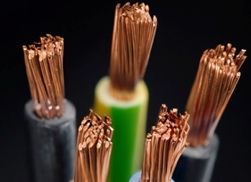Categories: Featured Articles » Sharing experience
Number of views: 298879
Comments on the article: 6
How to determine the cross section of a wire
 Everyone, at least a little connected with electrical engineering (and this is a household, garage, car) has to deal with electrical wiring, a wide variety of cables and wires. We often use all kinds of extension cords, portable sockets.
Everyone, at least a little connected with electrical engineering (and this is a household, garage, car) has to deal with electrical wiring, a wide variety of cables and wires. We often use all kinds of extension cords, portable sockets.
How to determine whether we use cable or wire cross-sections? "Old electricians" determine the cross-section of the wire "by eye". And we will try to calculate its cross-sectional area more precisely.
Usually the wire has a circular cross-sectional shape. However, the permissible current in the wire is calculated based on the cross-sectional area of the wire.
Determine the cross-sectional area of single-core and stranded wire. Open the wire sheath. If the wire is single-core, measure its diameter.
According to the "old, school" formula of the area of the circle, we determine the cross-sectional area of the wire.
S = π • d² / 4 or S = 0.8 • d² where:
S - wire cross-sectional area in mm.kv .;
π — 3,14;
d - wire diameter in mm.
For example: the diameter of our wire is d = 1.2 mm., Then S = 0.8 • 1.2² = 0.8 • 1.2 • 1.2 = 1.15 mm.
If the wire is stranded, you need to fluff it, calculate the number of veins in the bundle. Measure the diameter of one vein, calculate its cross-sectional area S. Then, adding the area of all the veins, determine the total cross-sectional area of the stranded wire.
For example: the number of veins in a stranded wire n = 19 pieces, the diameter of each vein d = 0.4 mm.
s = 0.8 • d² = 0.8 • 0.4 • 0.4 = 0.128 mm2
Cross-sectional area of the entire stranded wire
S = 37 • s = 19 • 0.128 = 2.43 mm2
You can measure the diameter of the wire core with a micrometer or vernier caliper. If you do not have such tools, the wire diameter can be determined using an ordinary ruler. The measured vein is tightly wound on a pencil. The number of turns is not less than 10 - 15 (the more turns, the more accurate the measurement). The ruler measures the winding distance in millimeters. This size is divided by the number of turns.
d = l/ n
Where l - winding distance in mm n - number of turns of wire.
It turns out the size of the diameter of the wire in millimeters.
See also at e.imadeself.com
:
